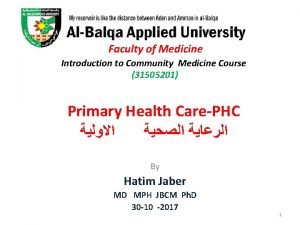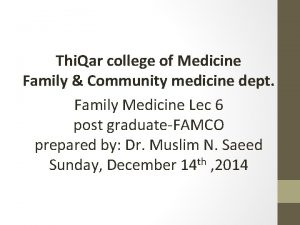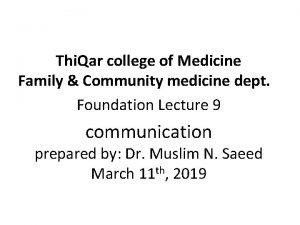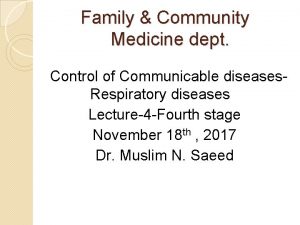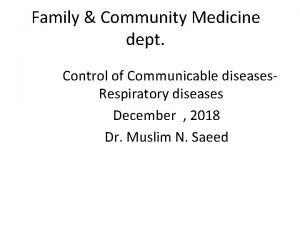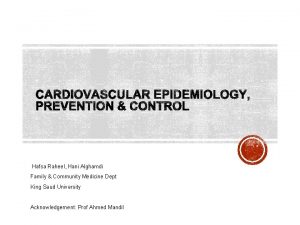THIQAR COLLEGE OF MEDICINE FAMILY COMMUNITY MEDICINE DEPT

















- Slides: 17

THIQAR COLLEGE OF MEDICINE FAMILY & COMMUNITY MEDICINE DEPT. FAMILY MEDICINE LEC 4 POST GRADUATE-FAMCO DR. MUSLIM N. SAEED TUESDAY, NOVEMBER 25 TH , 2014

PREVENTIVE SERVICES BY DISEASE CATEGORY Cancer: Almost one in every four deaths in the United States is caused by cancer, making it the second leading cause of death. In the United States the lifetime risk of a cancer diagnosis is one in two for men and one in three for women (ACS, 2009). #Potential harms arise when false-positive screens lead to unnecessary invasive testing or false-negative results lead to false reassurance.

PRIMARY PREVENTION OF CANCER EVIDENCE SUMMARY CA breast Minimize Risk Factor Exposure: 1. a. Hormo ne replace me nt the rapy —About 26% increased incidence of invasive breast CA with com bination hormone replac em ent therapy (HRT ) ( estr ogen and progesterone) —Est rog en alo ne with mixe d evidence—unlikely to increase risk b. Sign ificantly Ionizing radiat ion —Inc re ase d risk occurs abou t 10 years after exposure. Risk depends on dose and age at exposure c. O besi ty —RR = 2. 85 fo r breast CA for women > 82. 2 kg compared with wome n < 58. 7 kg d. Alc oh ol —RR f or int ak e of four alcoh olic drinks/day is 1. 32 —RR in cre ase s about 7% for each drink per d ay.

2. THERAPEUTIC INTERVENTION A…Tamoxifen (postmenopausal and high-risk premenopausal women) —Treatment with tamoxifen for 5 years reduced breast CA risk by 40%– 50%. Raloxifene (postmenopausal women) —Similar effect as tamoxifen in reduction of invasive breast CA. —Anastrozole reduces the incidence of new primary breast CAs by 50% compared with tamoxifen. —There is a 65% reduction in the risk of breast CA occurrence in postmenopausal women treated with exemestane for 5 years. B…. Prophylactic bilateral mastectomy (high-risk women ): —Reduces risk as much as 90% —About 6% of women were dissatisfied with their decision.

C…Prophylactic salpingo-oophorectomy among BRCA-positive women. —Breast CA incidence decreased as much as 50% —Nearly all women experience some sleep disturbances, mood changes, hot flashes, and bone demineralization. D…. Exercise —Exercising > 4 hours/week results in average risk reduction of 30%– 40% the effect may be greatest for premenopausal women of normal or low body weight. E…Breast-feeding —The RR of breast CA is decreased 4. 3% for every 12 months of breast-feeding, in addition to 7% for each birth. F…. Pregnancy before age 20 years: —About 50% decrease in breast CA compared with nulliparous women or those who give birth after age 35 years.

Cervical CA 1. Minimize Risk Factor Exposure: a……Abstinence of sexual activity; condom and/or spermicide use b……Cigarette smoke (active or passive) C……Human papillomavirus (HPV) infection: —Increases risk of high-grade cervical intraepithelial neoplasia (CIN) or invasive CA 2 -3 fold among HPV-infected women d……High parity —HPV-infected women with seven or more full-term pregnancies have a 4 -fold increased risk of squamous cell CA of the cervix compared with nulliparous women e……Long-term use of oral contraceptives —Increases risk by 3 -4 folds. —Longer use related to higher risk.

THERAPEUTIC 2. Therapeutic: a…. . HPV vaccination —Reduces incident and persistent infections, impact on longterm cervical CA rates also unknown but likely to be significant. b…. . Screening with Pap smears —Estimates from population studies suggest that screening may decrease CA incidence and mortality by more than 80%. Adding screening for HPV after age 30 years increases sensitivity

Colorectal CA: 1. Minimize Risk Factor Exposure: a…Excessive alcohol use, RR is 1. 41 for > 4. 5 drinks/day. b…Cigarette smoking—RR for current smokers versus never smokers 1. 18 c…Obesity—RR for woman with a (BMI) > 29 is 1. 45. Similar increase seen in colorectal CA (CRC) mortality. d…Regular physical activity—a meta-analysis of 52 studies showed a 24% reduction in incidence of CRC.

2. Therapeutic a…. . Based on solid evidence , (NSAIDs) reduce the risk of adenomas , but how much this reduces the risk of CRC is uncertain. —Based on solid evidence, daily aspirin use for at least 5 years reduces CRC incidence and mortality. b…. Postmenopausal combination hormone replacement (not estrogen alone). —Based on solid evidence, 44% reduction seen in CRC incidence among HRT users —Based on solid evidence, combination HRT users have a 26% increased invasive breast CA risk, a 29% increase in coronary heart disease (CHD) events, and a 41% increase in stroke rates. These risks obviate use of HRT for CRC prevention. c……Polyp removal —Based on fair evidence, removal of adenomatous polyps reduces the risk of CRC.

# Low-fat, high-fiber diet does not reduce the risk of CRC to a significant degree. # Statins do not reduce the incidence or mortality of CRC # Data are inadequate to show a reduction in the risk of CRC from calcium or vitamin D supplementation.

ENDOMETRIAL CA 1. Minimize Risk Factor Exposure: a…. Unopposed estrogen —Use in postmenopausal women (≥ 5 years of use = 10 -fold higher risk) b…. Obesity —risk increases 1. 59 -2 folds for each 5 kg/m change in body mass c…. Lack of exercise—regular exercise (2 hrs/week) with 38%– 48% decrease in risk. d…. Tamoxifen—used for > 2 years has a 2. 3– 7. 5 -fold increased risk of endometrial CA. e…. Nulliparous women have a 35% increased risk of endometrial CA.

2. Therapeutic interventions: a…. Oral contraception (estrogen and progesterone containing) —Use of oral contraceptions for 4 years reduces the risk of endometrial CA by 56%; 8 years, by 67%; and 12 years, by 72% b…. . Increasing parity and lactation — 35% reduction vs. nulliparous women.



Prostate CA 1. Minimize Risk Factor Exposure a……Family history of prostate CA in men aged < 60 years defines risk. One first-degree relative with prostate CA increases the risk 3 -fold, two first-degree relatives increase the risk 5 -fold. b……Incidence of prostate CA in African Americans increased, occurs at a younger age. # High dietary fat intake does not increase risk for prostate CA but is associated with aggressive cancers and shorter survivals

2. Therapeutic a…. . Finasteride Decreased 7 -year prostate CA incidence. Dutasteride associated with absolute risk reduction of 22. 8%. # Vitamin E/alpha-tocopherol—inadequate data—one study showed a 17% increase in prostate CA with vit. E alone. Skin CA : Sunburns (melanoma) Therapeutic: Sunscreen, protective clothing, limited time in the sun, avoid blistering sunburn in adolescence and young adults.

Thank you
 Types of family in community medicine
Types of family in community medicine Principles of primary care
Principles of primary care Duke family medicine and community health
Duke family medicine and community health Dept nmr spectroscopy
Dept nmr spectroscopy Florida department of agriculture and consumer services
Florida department of agriculture and consumer services Organizational structure of finance department
Organizational structure of finance department Worcester public health department
Worcester public health department Dept. name of organization (of affiliation)
Dept. name of organization (of affiliation) Mn dept of education
Mn dept of education Department of finance and administration
Department of finance and administration Dept. name of organization (of affiliation)
Dept. name of organization (of affiliation) Ohio dept of dd
Ohio dept of dd Poster affiliation
Poster affiliation Vaginal dept
Vaginal dept Gome dept
Gome dept Gome dept
Gome dept Gome dept
Gome dept Gome dept
Gome dept

